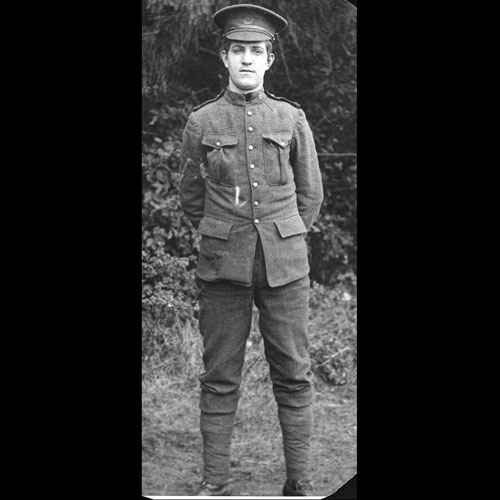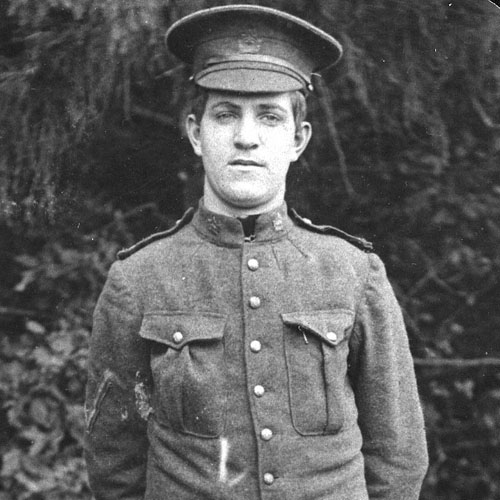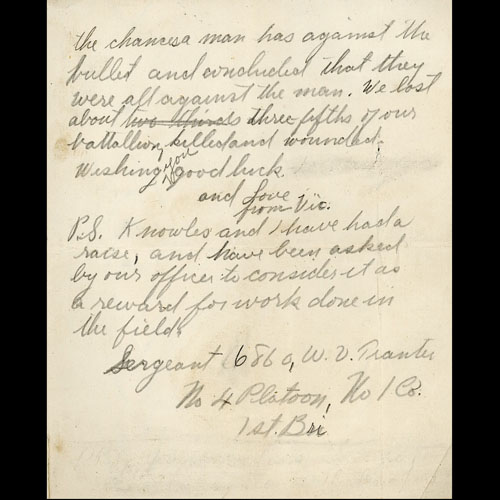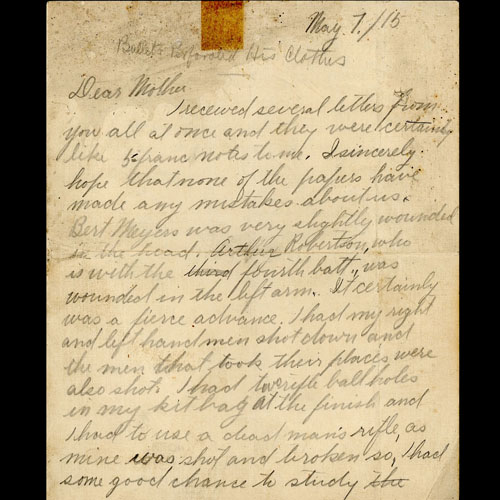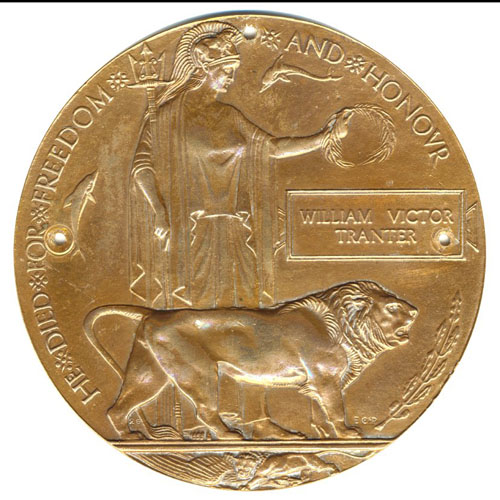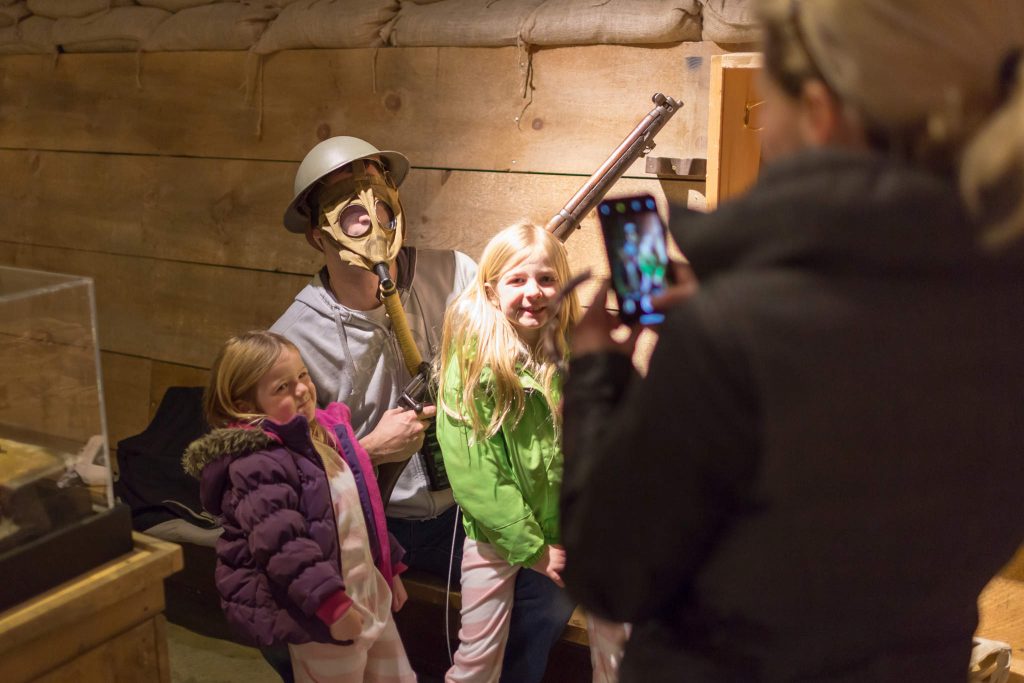I had some good chance to study the chances a man has against the bullet and concluded that they were all against the man.” Victor Tranter letter, May 7, 1915, after the Battle of Ypres
Primary sources and first-hand accounts of war-related experiences, such as letters and diaries, are excellent tools from which to gain more insight into the experiences of men who served during the First World War. Letters, a diary and other documents available at the Bruce County Archives provide insight into some of the thoughts, feelings, and experiences of the first young man from Southampton to die as a result of fighting in the First World War.
William Victor Tranter was born in Southampton, Ontario in 1894 to William and Annie Tranter. At the age of 20, he enlisted in the Canadian Overseas Expeditionary Force on September 15, 1914, only two months after the first declaration of war. His Attestation Paper gives a hint as to some of his motivation for volunteering to enlist so early in the War: his uncle, Captain Lionel Tranter who had served six years with the 32nd Bruce Regiment, witnessed Victor’s signature. A commitment to military service appears to have run in the family.
The primary training base for the 1st Canadian Division in 1914 was Valcartier, Quebec. A letter from Victor to his mother, dated April 4, 1914, mentions that he attended Easter Service in a barn, with about 400 men singing hymns to the music of the mouth organ, but still “I believe I would sooner be in St. Paul’s.”
The First Canadian Contingent sailed for England in October 1914 to training camps on the Salisbury Plains where training was rigorous and conditions were harsh. According to warmuseum.ca, “the Canadians trained for four months, most of it in terrible mud, as England experienced one of its wettest winters in decades.” Victor’s letter to his sister dated January 30, 1915 is addressed from “Bustard” which was one of the camps on the Salisbury Plains. The War Diary of the 1st Canadian Infantry Brigade indicates that on January 30, the brigade participated in “refilling of trenches and battalion training. Half holiday in afternoon.” Perhaps Victor took advantage of that half-holiday to write some letters, including the one to his sister.
In that letter, he says “I think we are going to put in two months training in France and may move any time. … We will be going to the South of France – Summer all the time.” Victor enclosed “a couple little Irish Green Marble pigs”, possibly souvenirs from a stop in Dublin.
His diary confirms a departure from England, indicating that on Sunday, February 7, “Marched to Amebsury / Took train to Avonmouth.” Additional entries over the next few days provide some commentary on his travel experience:
February 9: “Took cattle boat to quarters. Very uncomfortable.”
February 10: “Sea very wet and everybody sick. Received 1st ration of day B & Bull B [Bread & “Bully Beef”] … arrived at St. Nizzare, France late in evening. Glad to get ashore.”
February 11: “Took very uncomfortable train (cattle train). Could get no sleep.”
Victor’s first mention of coming near the front lines was on February 16: “Could hear very heavy firing. All day and night.” The following day, he writes “Marched to Armentiers – centre of line – firing very loud – several buildings destroyed.” On Saturday, February 20: “Seeing real war for the first time – boys all cool.” The 1st Canadian Field Artillery Brigade War Diary entry for February 20 provides additional detail: “Dug in with overhead cover from aeroplanes. Aircraft had dropped bombs which did not fall within 100 yds. of this position.”
The Canadian Division faced its first real test during the defence of St. Julien beginning on April 22, 1915. In a letter to his Mother, on April 22, 1915, Victor writes, “I am writing again and of course, as usual, cannot find much to say.” One can only imagine all of the things he didn’t care to share. His diary reveals an entry on that day: “Left for Yser Canal near Ypres”. His letter was written just before his arrival at the Second Battle of Ypres where the Canadian Division suffered 6000 casualties over a four-day period (warmuseum.ca).
On April 23, Victor wrote in his diary: “Advance under rifle shell fire about 3/5 of Batt = Casulaties. 5 Casulaties in my section. Major & Captain wounded. Also my Lance Cpl Johnston of Chesley Ont. shot in the wrist. Boys fought well under fire.” The next day, “Marched and dug in near Ypres. Rained all night.”
We can only imagine the distress his mother experienced upon reading Victor’s May 7, 1915 letter to her: “I had my right and left hand men shot down and the men that took their places were also shot. I had two rifle ball holes in my kit bag at the finish and I had to use a dead man’s rifle, as mine was shot and broken.” She must have been relieved at his survival to tell the tale, but horrified at his acknowledgement that “3/5 of our battalion killed & wounded.” His postscriptt “Knowles and I have had a raise, and have been asked by our officer to consider it as a reward for work done in the field” was likely little consolation. An air of foreboding surrounds the letter as he wrote: “… so I had some good chance to study the chances a man has against the bullet and concluded that they were all against the man.”
Two weeks later, his Brigade was in action again at Festubert in the Artois region of France. The Canadians made small gains, but incurred over 2,000 more casualties within the week through a series of largely unsuccessful attacks (warmuseum.ca). Victor was one of the casualties.
Some of his final diary entries include:
May 23: Buried some men.
May 24: Birthday, Awakened by the burning of several shrapnel wounds.
May 25: In Anglo American Hospital.
May 31: Took out some shrapnel
June 6: Took communion
June 7 (final entry): More shrapnel removed.
His Canadian Expeditionary Forces Death Certificate and obituary indicate that he died on June 10, 1915 of wounds received at the battle of Festubert, at age 21.
The entire town of Southampton must have felt for his death, the first of the Great War for their town. The Town sent a heartfelt letter of sympathy to Mr. and Mrs. Tranter commenting, “He has ‘quit himself well,’ his spirit is far above the trenches in which he fought and we believe him safe in the care and love of the house prepared for him by the One who made sacrifice glorious in giving Himself for us.” A letter from the Chaplain of The Anglo-American Hospital dated June 12, 1915 to Mrs. Tranter describes the funeral of her son and the sympathy expressed by Lady Hadfield, and encloses a photograph of the cemetery and location of Victor’s grave. He closes the letter saying, “There is so little that we seem to be able to do for you all who are so far away.” Even his Nurse, Sister Rose, sent Mrs. Tranter a post card “in memory of her patient.”

